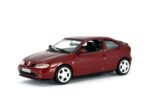The development of the first Laguna took surprisingly long. It began in 1988, but was halted in the early 90s. The works resumed after a year and their effect was shown to the world at the end of 1993. When designing the car, a lot of inspiration was taken from the Safrane, however the Laguna has a much neater body design than its larger cousin. Opting for the sporty-elegant look was a good decision – after more than 20 years after its debut, the car still looks good, especially when you compare it to the Citroen Xantia or the Peugeot 406.
When launching the Laguna, the company made a bold decision not to offer a saloon in the range. The client could only choose between a liftback and an estate. As opposed to the liftback, the design of the estate was announced by the sleek prototype Laguna Evado.
The Laguna Grandtour I’m presenting you today is the pre-facelift version, done by Vitesse. The model car has a vibe typical of the manufacturer. We can be awed by the beautifully detailed interior with a coloured and patterned upholstery (still a rarity amongst 1:43 models) and the opening parts. The opening parts definitely do set apart Vitesse products from the competition, but it does mean that the model isn’t put together as sharply. It can be clearly seen at the front, where the gaps between the bonnet and the bodywork are way too big. It has to be said however, that once you open the bonnet, you’ll see the beautifully detailed engine, which partly compensates for the not-too-subtle gaps. The paintwork is also worth mentioning. It is well put on the model and has a deep, elegant colour that, unfortunately, turns out to be a real challenge to photograph. Despite many attempts, I have not managed to capture how this colour looks in real life.
The Renault
Laguna I was presented at the end of 1993, with the sales starting at the
beginning of the next year. In 1995 the estate version named Grandtour joined
the range. The clients had a choice of 4 trim levels: RN, RT, RXE and V6. The
engine line-up included: 1.8, 2.0 and 3.0 V6 petrol units and also a 2.2 d
turbodiesel. In 1998 the car received a small facelift. Apart from slight
changes to the interior and exterior, there were also changes in the engine
range (a 1.6 16V petrol engine was added for example) and trim levels (RNE,
RTE, RXE, RXT). In 2000 a limited edition was introduced called, depending on
the market, Concorde or Millenium. In the same year a modern 1.9 dCi diesel
engine was also added to the range. The production of Laguna I ended in 2001.
pierwszej generacji trwały zaskakująco długo. Zaczęto je w 1988 roku, ale
przerwano je na początku lat 90-tych. Do prac powrócono dopiero po roku, a ich
końcowy efekt świat ujrzał pod koniec 1993 r. Przy projektowaniu auta
inspirowano się modelem Safrane, jednak Laguna od swojego większego kuzyna jest
znacznie zgrabniejsza. Postawienie na sportową elegancję wyszło marce na dobre
– po ponad 20 latach od debiutu samochód nadal dobrze się prezentuje,
szczególnie w porównaniu do Citroena Xantii czy Peugeota 406.
sprzedaży, producent zdecydował się na nietypowy ruch i zrezygnował z
oferowania klasycznego sedana. Klient miał do wyboru tylko liftbacka albo
kombi. W przeciwieństwie do podstawowej wersji nadwozia, wygląd kombi
zapowiedział efektowny prototyp Laguna Evado.
Laguna Grandtour to wersja przedliftingowa, zrobiona przez firmę Vitesse.
Modelik ma typowy dla tej firmy klimat. Możemy w nim podziwiać wspaniale
odwzorowane wnętrze z wzorzystą tapicerką (do dzisiaj rzadkość wśród modeli) a
także otwierane elementy. Otwierane części wyróżniają produkty Vitesse na tle
konkurencji, z drugiej strony jednak stwarzają problemy z dokładnością montażu.
Jest to widoczne szczególnie z przodu, gdzie szczeliny między maską a nadwoziem
są zbyt duże. Trzeba jednak przyznać, że po otwarciu maski oczom ukazuje się
bardzo ładnie odwzorowany silnik, co częściowo rekompensuje niezbyt subtelne szczeliny.
Należy również wspomnieć o lakierze. Jest dobrze położony i ma ładną, elegancką
barwę, która jednak okazuje się nie lada wyzwaniem do sfotografowania. Pomimo
wielu prób, nie udało mi się w pełni oddać tego, jak ten kolor prezentuje się
na żywo.
zaprezentowana pod koniec 1993 r., a do sprzedaży trafiła na początku
następnego roku. W 1995 r. do oferty dołączyło kombi nazwane Grandtour. Do
wyboru klient miał 4 wersje wyposażenia: RN, RT, RXE i V6. Do napędu używano
benzynowych silników 1.8, 2.0 oraz 3.0 V6 a także turbodiesla 2.2 d. W 1998 r.
samochód przeszedł drobny facelifting. Oprócz lekkich zmian nadwozia i wnętrza,
wprowadzono też zmiany w gamie silnikowej (wprowadzono m.in. silnik 1.6 16V) oraz
zmieniono poziomy wyposażenia (RNE, RTE, RXE, RXT). W 2000 r. wprowadzano do
gamy wersję limitowaną nazwaną, w zależności od rynku, Concorde albo Millenium
a także nowoczesny silnik wysokoprężny 1.9 dCi. Produkcję Laguny I zakończono w 2001
r.
 |
| Renault Laguna I Grandtour 1995 (1:43) by Vitesse |











Vitesse zdecydowanie na nie, podobnie jak otwierane elementy;) nie znosze ruchomych elementów w modelach, zwłaszcza osobowych. Nie mniej jednak, nie znam zbyt wielu modeli Laguny I stąd przyznam, że dla fana marki Renault może stanowić nie lada gratkę;)
Pozdrawiam;)
Akurat ten Vitesse nie jest taki najgorszy. Mieli gorsze momenty xD. Jeśli chodzi o miniatury przedliftingowych Lagun pierwszej generacji, to z tego co wiem mamy tylko modele Vitesse. Poliftingowa Phase II robiona była też przez UH.